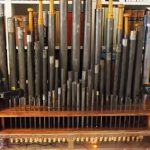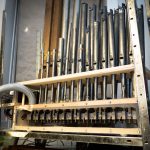The first EnsembleBot instruments were all percussive instruments like the tubular bells and drums. Hitting things with solenoids is fun, and the Robro project was well underway (though still far from finished), but making sounds with air just opens up a lot of interesting ways to make music. So interesting, in fact, that the wind projects now dominates the EnsembleBot.
- PipeDream24 – The first pipe organ. A 24-note prototype built of assorted scrap pipes.
- PipeDream61 – The first full organ stop (61 notes) organ using a stop of 4-foot diapason pipes from a decomissioned church organ.
- PipeMare – An insane project combining two organ stops and a deconstructed accordion in one instrument.
- PipeWind – Any pipe organ needs air, and many organs need much more air.
EARLY IDEAS
The very first idea was to make a slide whistle or lotus flute, and rig it to be tuned by a servo motor. Although this idea may be picked up again in the future, the tonal range is quite limited (about one octave), and it wouldn’t amount to much more than a gimmick.
The next idea was to make an air-powered calliope. Making a few pipes out of pieces of e.g. plastic tubing is easy, but making several octaves becomes tricky, as you’ll need many sizes (diameters) of tubing.
Then, by chance, I stumbled upon a bunch of cheap, old organ pipes. Even though they were mismatched, they were better than anything I could make myself. Soon, I had enough pipes for two octaves, but no idea of how to make them play. Besides the pipes themselves, you need several things to make any kind of organ, notably some sort of air supply and a valve mechanism to enable or disable the air flow to each pipe to make it sound or stop.
Working our way backwards from the pipes, the first order of business is figuring out a valve system to reliably opening an air stream to the pipe and closing it again. The early plans were to use arrays of electromagnetic pressure valves of different kinds, but that idea was quickly abandoned.
In the end, I had to resort to reading a lot of books on pipe organ building and to learn how the real deal actually works. This gave the project a much needed design direction, not only for the valves, but also for what was needed in terms of air supply.
PIPE ORGANS FOR DUMMIES
A real pipe organ, like the great organs of churches and cathedrals, are fantastically complex machines based on know-how and techniques accumulated over many centuries. Because I was (am) a dummy, I’ll try to make it much simpler and cheaper.
But no matter how simple we make it, there are still some fundamental parts of any pipe organ that must be considered:
- A blower to produce the wind to make sound in the pipes. The blowers in modern organs are powerful electrical motor blowers.
- A pressure regulator to ensure a constant air pressure to the organ. The pressure regulator is usually a combination of some kind of bellows and an air reservoir. This is a very important component. Organ pipes are very sensitive to pressure changes, because they result in noticeable pitch shifts. The pressure must be held constant and compensated, and without a pressure regulator the pressure would change depending on which and how many pipes are playing at any given moment. The regulator is placed between the blower and the organ windchests.
- A windchest under pressure with valves for letting out air into the pipes. The windchest itself is basically just an airtight box with a large air inlet from the blower/regulator, and a number of valves.
- The valves are normally closed, keeping the air inside the windchest. But on command (either mechanically, pneumatically or electrically) a valve can open to let out air from the pressurized windchest and into a pipe. In a typical organ the valve opens as the player presses a key on the manual to play a note. Our “player”, however, is the EnsembleBot.
- A toeboard and a pipe rack for mounting and securing the pipes. The toebard is in our case just the top side of the windchest. It’s called a toeboard because the bottom part of an organ pipe, where the air is blown in, is called the toe. The toeboard has holes prepared for the toe of each pipe, and to keep the pipes securely upright they are supported by a pipe rack. This is simply a raised board with holes for the pipe feet (the lower conical bit of the pipes).
- And, of course, the organ pipes themselves. There are many types and sizes of organ pipes, but we have chosen our pipes solely on availability, price and size.

Now, of course, a real church organ has many more essential components, and each of them infinitely more complex and intricate, than I’m able to make them. And, of course, a real organ has manuals enabling a human to play the organ. But we try to keep it simple, and like in space travel, the best way to simplify things is to remove the human component altogether.
In parallel with designing and building the organs, there was also a lot of the work going on to design and improve the air systems.
ORGAN PROJECTS
The first organ was a now decomissioned prototype organ called the PipeDream24. As mentioned above, it was made of 24 old and mismatched pipes, but it served as an invaluable proof of concept for the later organ projects.
As an air supply for the PipeDream24, I built a small blower box and pressure regulator. This was named the PipeWind v.1.

After the prototype organ, I got my hands on a set of 4-foot diapason pipes, a full stop of 61 notes. These were pulled out of an old church organ in England. These pipes were the basis for the next organ, the PipeDream61.
As the PipeDream61 used more air, and more projects were under way, work began building a larger air system, called PipeWind v.2.
One of the early extra projects was the Zimbelstern. This is a kind of sound effect or gimmick, often found in baroque organs.
The latest organ project is the PipeMare, consisting of no less than two pipe organ stops and an automated accordion.

